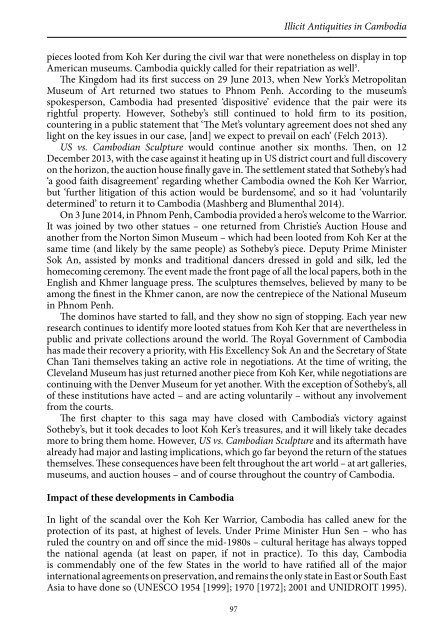Countering
Book_observatory_illicit_traffic_version%20issuu
Book_observatory_illicit_traffic_version%20issuu
You also want an ePaper? Increase the reach of your titles
YUMPU automatically turns print PDFs into web optimized ePapers that Google loves.
Tess Davis<br />
Indeed, when the decade-long Vietnamese occupation of the country ended in 1989 –<br />
during the so-called ‘transitional period’ before Cambodia even had a fully functioning<br />
government – Phnom Penh was already taking steps to implement the 1970 Convention<br />
on the Means of Prohibiting and Preventing the Illicit Import, Export and Transfer<br />
of Ownership of Cultural Property, more commonly known as the 1970 UNESCO<br />
Convention, which remains the leading international law on the illicit antiquities trade<br />
(Askerud and Clément 1997: 5-6). As part of these efforts, in 1993, Cambodia worked with<br />
the International Council of Museums (ICOM) to publish One Hundred Missing Objects:<br />
Looting in Angkor (ICOM 2015). This selection of items stolen from the Conservation<br />
d’Angkor in the 1980s and 1990s brought international attention to Cambodia’s plight,<br />
and eventually led to the repatriation of around a dozen masterpieces, including three<br />
that had once gone on the block at Sotheby’s (National Museum of Cambodia 2015).<br />
Also in 1993, the Kingdom’s new constitution required the State to ‘preserve and<br />
promote national culture’ including ‘ancient monuments and artifacts’ and further<br />
stipulated, in Articles 69 and 70, that ‘any offense affecting cultural artistic heritage shall<br />
carry a severe punishment’. While crimes against cultural property had been roughly<br />
addressed by the transitional period’s penal code, in 1996, the National Assembly<br />
strengthened these provisions, adopting the Law on the Protection of Cultural Heritage,<br />
in accordance with international best practices. However, despite these accomplishments,<br />
during the 1990s and early 2000s, top government and military officials (many in Hun<br />
Sen’s one Cambodian People’s Party) still faced repeated accusations of involvement in<br />
the illicit antiquities trade. These claims have lessened in the last few years, replaced<br />
instead with high profile arrests and convictions, which would have been inconceivable<br />
just a decade ago 6 . Such ground-breaking cases, while remaining few and far between,<br />
suggest that once ‘untouchable’ figures may now finally be held legally accountable for<br />
their role in plundering the country’s past.<br />
US vs. Cambodian Sculpture came at a volatile time in Cambodian politics, overlapping<br />
exactly with the lead-up to and fallout from – the 2013 general elections, the results of<br />
which were strongly contested by the opposition (as well as some international observers).<br />
Post-election protests, and outbreaks of violence, were frequent until a new government<br />
formed in July 2014 (Sockhea and Ponias 2014). During the standoff, in which some<br />
politicians openly warned of a return to civil war, Cambodia’s fight to recover the Koh<br />
Ker statues ranked among the few positive headlines in the country.<br />
The common enemy of Sotheby’s – alongside others deemed responsible for<br />
plundering Cambodia’s past, from the former colonial powers to the modern art<br />
market – proved to unify the Khmer people across party lines. There were even protests<br />
held against the auction house in Phnom Penh. In such an otherwise divisive time, the<br />
importance of taking back the country’s stolen heritage was one subject on which all<br />
Cambodians agreed, regardless of their political persuasion. No doubt this opportunity<br />
was not lost on Hun Sen, who is recognized as a seasoned politician, even by his most<br />
ardent critics.<br />
Today, Hun Sen’s administration has taken an increasingly prominent role on the<br />
world stage when it comes to cultural preservation, despite receiving heated international<br />
criticism for alleged corruption, election fraud, and other human rights abuses. In June<br />
2013, Cambodia hosted the 37 th session of the World Heritage Committee Meetings in<br />
Phnom Penh, a major honour that ranks it alongside such metropolises as Paris (2011),<br />
Saint Petersburg (2012), and Doha (2014). This event happened to coincide with the Met’s<br />
return of two statues from Koh Ker, and the repatriation ceremony actually opened the<br />
98


